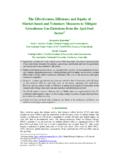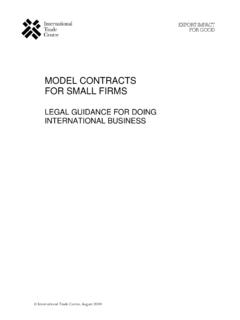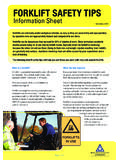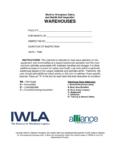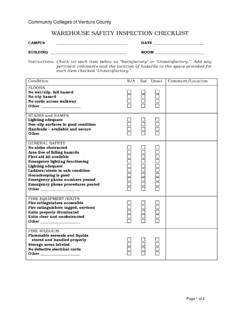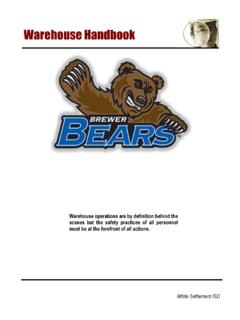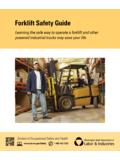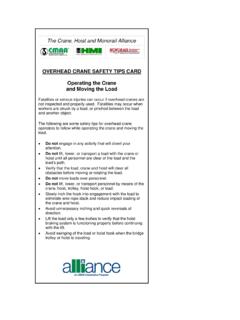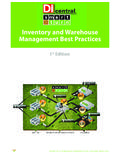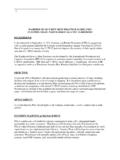Transcription of o 5S: GOOD HOUSEKEEPING TECHNIQUES FOR ENHANCING ...
1 5S: good HOUSEKEEPING TECHNIQUES FOR ENHANCING PRODUCTIVITY, QUALITY AND safety AT THE WORKPLACEExPORT QUALITY BULLETIN No 89/20125S: good HOUSEKEEPING TECHNIQUES ii 5S: good HOUSEKEEPING TECHNIQUES iii 5S: good HOUSEKEEPING TECHNIQUES FOR ENHANCING PRODUCTIVITY, QUALITY AND safety AT THE WORKPLACE 5S: good HOUSEKEEPING TECHNIQUES iv The designations employed and the presentation of material in this document do not imply the expression of any opinion whatsoever on the part of the International Trade Centre concerning the legal status of any country, territory, city or area or of its authorities, or concerning the delimitation of its frontiers or boundaries. This document has not formally been edited by the International Trade Centre. This bulletin provides information on 5 S good HOUSEKEEPING TECHNIQUES which can be used as a tool for systematic approach for productivity, quality and safety improvement in all types of business.
2 This bulletin has been prepared, without formal editing, by Y. C. Ennin and D. Obi, ITC Interns, under the guidance of K. Ramful, Senior Adviser on Export Quality Management, and in cooperation with L. Ghizzoni, Adviser on Export Quality Management, and H. Menon, Trade Training Officer, Enterprise Competitiveness Section, Division of Business and Institutional Support, International Trade Centre (ITC). For more information: Street address: ITC, 54-56 rue de Montbrillant, CH 1202 Geneva, Switzerland Postal address: ITC, Palais des Nations, 1211 Geneva 10, Switzerland Telephone: + Fax + E-mail: - Internet: 5S: good HOUSEKEEPING TECHNIQUES v Contents 1. What is 5S all about? .. 1 2. What is the meaning of 5S? .. 1 3. Why do we practice the 5S? .. 2 4. How do we practice the 5S? .. 3 SORT - SEIRI .. 3 SET IN ORDER - SEITON .. 4 SHINE - SEISO .. 5 STANDARDIZE - SEIKETSU .. 6 SUSTAIN - SHITSUKE.
3 7 5. What is management s role in implementing 5S? .. 9 6. Additional guidelines for implementing 5S .. 10 Annexes I. Diagnostic Checklist for II. Applying 5S in a Quality Improvement Project in the Light Engineering Sector (LES) in Table 1. The five steps of Japanese 5 S .. 1 Table 2. Sort - Seiri .. 4 Table 3: Set-in-order - Seiton .. 5 Table 4. Shine - Seiso .. 6 Table 5: Standardize Sieketsu .. 7 Table 6. Sustain - Shitsuke .. 8 5S: good HOUSEKEEPING TECHNIQUES 1 1. What is 5S all about? 5S is amongst the first and fundamental steps implemented by an enterprise towards the path of implementing Total Quality Management and continuous improvement at the operation level. 5S is a process designed to organize the workplace, keep it clean, maintain effective and standard conditions. It instils the discipline required to enable each individual to achieve and maintain a world-class environment.
4 The use of this tool was started in 1972 by Henry Ford in the United States as the CANDO programme: Cleaning up, Arranging, Neatness, Discipline and Ongoing improvement. The technique was popularized as Japanese 5S in 1980 by Hiroyuki Hirano. Many enterprises have practiced the 5S and derived significant benefits from it. In particular, this technique has been widely practiced in Japan. Most Japanese 5S practitioners consider 5S useful not just for improving their physical environment, but also for improving their thinking processes too. In Japan it is also called workplace management . 5S will be needed if the workplace is messy and unorganized. It will also be needed if employees spend extra time in searching tools, papers, information, etc. 2. What is the meaning of 5S? 5S is the acronym for five Japanese words: Seiri, Seiton, Seiso, Seiketsu and Shitsuke and they represent the five steps for a systematic technique for good HOUSEKEEPING as indicated in the table below: Table 1.
5 The five steps of Japanese 5 S Step Corresponding action Seiri (Sort) Distinguish between necessary and unnecessary items. Remove the latter. Seiton (Set in order) Enforce the dictum a place for everything and everything in its place . Seiso (Shine) Clean up the workplace and look for ways to keep it clean. Seiketsu (Standardize) Maintain and monitor adherence to the first three Ss. Shitsuke (Sustain) Follow the rule to keep the workplace 5S-right. Hold the gain. 5S: good HOUSEKEEPING TECHNIQUES 2 Figure 1. The five steps of Japanese 5 S 3. Why do we practice the 5S? The general concept of the 5S is that they are intended to eliminate waste (Osada, 1993). Working in disorder is neither productive, nor safe. 5S is a simple and practical method to instil a quality culture at the work place. It is relatively easy to undertake, and requires minimal additional resources.
6 The first and small investment made in time and effort pays off in a much bigger manner when the results are realized and maintained. Among the main benefits of implementing 5S are: the workplace becomes cleaner, safer, well-organized and more pleasant floor space utilization is improved workflow becomes smoother and more systematic and non-value added activities are reduced; time for searching tools, materials and document is minimized; machine breakdowns are reduced since clean and well-maintained equipment breaks down less frequently and it also becomes easier to diagnose and repair before breakdowns occur, therefore extending equipment life; errors are minimized leading to making defect-free products; consumables and material wastage are minimized; the morale and satisfaction of employees improves; and the productivity of the organization improves together with the quality of products and services.
7 5S: good HOUSEKEEPING TECHNIQUES 3 Figure 2. Disorder is neither productive nor safe Source: Micazen Consulting & Technologies ( ) 4. How do we practice the 5S? The meaning, methods of implementing and benefits of each of the 5S are given below. SORT - SEIRI The emphasis of Seiri is on stratification management and being able to spot the unwanted and unnecessary before they become problematic (Osada, 1993). Figure 3: Sort - Seiri 5S: good HOUSEKEEPING TECHNIQUES 4 Table 2. Sort - Seiri Meaning Methods Benefits This means distinguishing or sort out between wanted and unwanted items at place of work and removal of unwanted items First decide what is necessary and what is unnecessary. To find out unnecessary items you should not only check the floor but also shelves, lockers, storehouse, stairs, roofs, notice boards, etc. Your useful floor is saved. Your searching time of tools, materials, and papers is reduced.
8 You have better flow of work. Your inventory cost of unnecessary items is reduced. Put a red tag on unnecessary items and keep them in a separate area. Discard or throw those items which have not been used in the past one year. Things used once in 6 to 12 months may be stored at a distance from work station. Things used more than once a month should be available at a central point in the workplace. Things used hourly/everyday/once a week should be near the work station or may be worn by or kept in the pocket of your worker there. SET IN ORDER - SEITON Seiton in essence can be defined as neatness, having things in the right places or set up so that they are readily available for use, eliminating the need to search. Once everything has a right place so that it s functionally placed for quality and safety , it can then be deemed that the workplace is neat (Osada, 1993).
9 While Seiri helps you to decide what items are needed, Seiton helps you to decide the way things are to be placed. Figure 4: Set-in-order - Seiton Source: 5S Best Practices( ). 5S: good HOUSEKEEPING TECHNIQUES 5 Table 3: Set-in-order - Seiton Meaning Methods Benefits Arranging items in such a manner that they are easy to use. Labelling them so that they are easy to find and put back. This means a place for everything (necessary) and everything in its place. No more homeless items. If necessary, reassign spaces, racks, cabinets, etc. Decide the right places for everything. Put all materials and equipment at a place allocated to them with proper label or signalization. Use alerts or indications for out-of-stock situations. Use floor paint marking to define working area, path, entrance/exit, safety equipment, cart/ trolley locations, etc.
10 Use standard colour coding for pipelines for steam, water, gas, drainage, etc. Use display cautions, messages, instructions at proper place at proper height and written clearly You take things out and keep things back easily. You make lesser mistakes. You reduce searching time. Your work environment becomes safe SHINE - SEISO Seiso places emphasis on cleaning so that things are clean; in other words carrying out cleaning as a form of inspection getting rid of waste, and foreign matter. It is important to note that depending on the circumstance, with higher quality, higher precision and finer processing technologies, even the minute details may have the greatest ramifications, hence the importance to carry out cleaning as a form of inspection (Osada, 1993). Figure 5: Shine - Seiso Source: ENNA ( ) 5S: good HOUSEKEEPING TECHNIQUES 6 Table 3.




